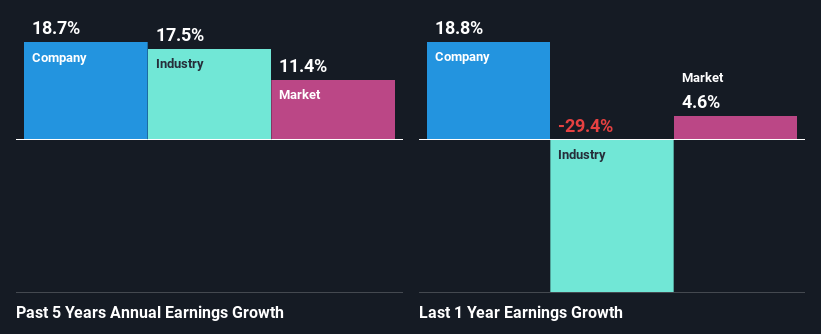Declining Stock and Solid Fundamentals: Is The Market Wrong About Antofagasta plc (LON:ANTO)?
With its stock down 9.3% over the past week, it is easy to disregard Antofagasta (LON:ANTO). But if you pay close attention, you might gather that its strong financials could mean that the stock could potentially see an increase in value in the long-term, given how markets usually reward companies with good financial health. Particularly, we will be paying attention to Antofagasta's ROE today.
Return on equity or ROE is a key measure used to assess how efficiently a company's management is utilizing the company's capital. Simply put, it is used to assess the profitability of a company in relation to its equity capital.
Check out our latest analysis for Antofagasta
How Is ROE Calculated?
ROE can be calculated by using the formula:
Return on Equity = Net Profit (from continuing operations) ÷ Shareholders' Equity
So, based on the above formula, the ROE for Antofagasta is:
17% = US$2.0b ÷ US$12b (Based on the trailing twelve months to December 2022).
The 'return' is the income the business earned over the last year. That means that for every £1 worth of shareholders' equity, the company generated £0.17 in profit.
What Is The Relationship Between ROE And Earnings Growth?
We have already established that ROE serves as an efficient profit-generating gauge for a company's future earnings. We now need to evaluate how much profit the company reinvests or "retains" for future growth which then gives us an idea about the growth potential of the company. Assuming everything else remains unchanged, the higher the ROE and profit retention, the higher the growth rate of a company compared to companies that don't necessarily bear these characteristics.
Antofagasta's Earnings Growth And 17% ROE
To start with, Antofagasta's ROE looks acceptable. Even when compared to the industry average of 15% the company's ROE looks quite decent. This probably goes some way in explaining Antofagasta's moderate 19% growth over the past five years amongst other factors.
As a next step, we compared Antofagasta's net income growth with the industry and found that the company has a similar growth figure when compared with the industry average growth rate of 18% in the same period.
Earnings growth is an important metric to consider when valuing a stock. It’s important for an investor to know whether the market has priced in the company's expected earnings growth (or decline). By doing so, they will have an idea if the stock is headed into clear blue waters or if swampy waters await. If you're wondering about Antofagasta's's valuation, check out this gauge of its price-to-earnings ratio, as compared to its industry.
Is Antofagasta Using Its Retained Earnings Effectively?
The high three-year median payout ratio of 77% (or a retention ratio of 23%) for Antofagasta suggests that the company's growth wasn't really hampered despite it returning most of its income to its shareholders.
Besides, Antofagasta has been paying dividends for at least ten years or more. This shows that the company is committed to sharing profits with its shareholders. Existing analyst estimates suggest that the company's future payout ratio is expected to drop to 47% over the next three years. However, Antofagasta's future ROE is expected to decline to 9.0% despite the expected decline in its payout ratio. We infer that there could be other factors that could be steering the foreseen decline in the company's ROE.
Summary
Overall, we are quite pleased with Antofagasta's performance. We are particularly impressed by the considerable earnings growth posted by the company, which was likely backed by its high ROE. While the company is paying out most of its earnings as dividends, it has been able to grow its earnings in spite of it, so that's probably a good sign. Having said that, on studying current analyst estimates, we were concerned to see that while the company has grown its earnings in the past, analysts expect its earnings to shrink in the future. Are these analysts expectations based on the broad expectations for the industry, or on the company's fundamentals? Click here to be taken to our analyst's forecasts page for the company.
Have feedback on this article? Concerned about the content? Get in touch with us directly. Alternatively, email editorial-team (at) simplywallst.com.
This article by Simply Wall St is general in nature. We provide commentary based on historical data and analyst forecasts only using an unbiased methodology and our articles are not intended to be financial advice. It does not constitute a recommendation to buy or sell any stock, and does not take account of your objectives, or your financial situation. We aim to bring you long-term focused analysis driven by fundamental data. Note that our analysis may not factor in the latest price-sensitive company announcements or qualitative material. Simply Wall St has no position in any stocks mentioned.

 Yahoo Finance
Yahoo Finance 
